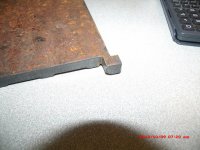singleslammer
Plastic
- Joined
- Jun 7, 2017
Hello all,
I have a Dynatorch Super B that I am learning to use. This is my first CNC device having only worked with "dumb" tools in the past. I am looking for a guide of common errors and their causes so I can educated myself without taking up a ton of time on here. I have attached my current issue just to give you an idea of what I am dealing with. This is 1/4" plate mild cut at 65 amps at around 100 ipm if memory serves. Also, this is the back side of the cut. I think my issue was that I tend to use sharp corners where I should have used rounded corners here.
Thanks, Jordan
![IMG_20171102_213937435[1].jpg IMG_20171102_213937435[1].jpg](https://www.practicalmachinist.com/forum/data/attachments/178/178735-98a429de36f390a1260ad79a51c048dc.jpg)
![IMG_20171102_213945845[1].jpg IMG_20171102_213945845[1].jpg](https://www.practicalmachinist.com/forum/data/attachments/178/178736-949c6c8c7c2b3d2fa19c7a1a964c5c67.jpg)
I have a Dynatorch Super B that I am learning to use. This is my first CNC device having only worked with "dumb" tools in the past. I am looking for a guide of common errors and their causes so I can educated myself without taking up a ton of time on here. I have attached my current issue just to give you an idea of what I am dealing with. This is 1/4" plate mild cut at 65 amps at around 100 ipm if memory serves. Also, this is the back side of the cut. I think my issue was that I tend to use sharp corners where I should have used rounded corners here.
Thanks, Jordan
![IMG_20171102_213937435[1].jpg IMG_20171102_213937435[1].jpg](https://www.practicalmachinist.com/forum/data/attachments/178/178735-98a429de36f390a1260ad79a51c048dc.jpg)
![IMG_20171102_213945845[1].jpg IMG_20171102_213945845[1].jpg](https://www.practicalmachinist.com/forum/data/attachments/178/178736-949c6c8c7c2b3d2fa19c7a1a964c5c67.jpg)


